Exploring Policy Making: Influential Groups, Power, and Government
VerifiedAdded on 2023/06/10
|5
|852
|296
Essay
AI Summary
This essay delves into the intricate process of policy making, exploring the influence of various groups and the government's role in shaping policy decisions. It examines how influential groups set agendas, relating their actions to Luke's dimensions of power. The essay further discusses the roles of stakeholders, public servants, and special interest groups in influencing government decisions. It analyzes whether the government operates independently or reflects the power distribution within society, considering both elitist and pluralist viewpoints. The analysis provides a comprehensive understanding of the dynamics involved in policy creation and the various factors that impact the final outcome. Desklib offers this essay and many other resources to aid students in their studies.
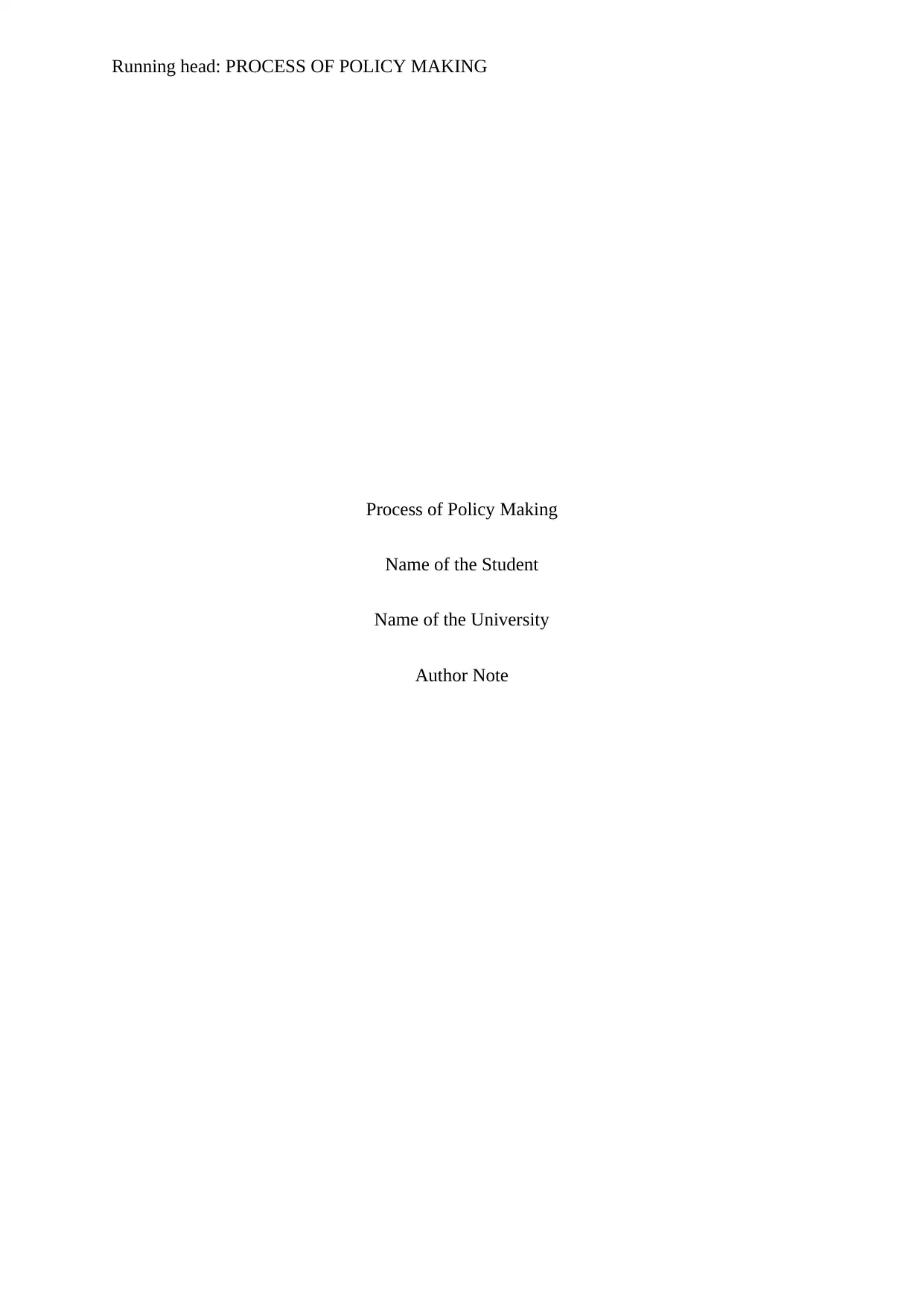
Running head: PROCESS OF POLICY MAKING
Process of Policy Making
Name of the Student
Name of the University
Author Note
Process of Policy Making
Name of the Student
Name of the University
Author Note
Paraphrase This Document
Need a fresh take? Get an instant paraphrase of this document with our AI Paraphraser
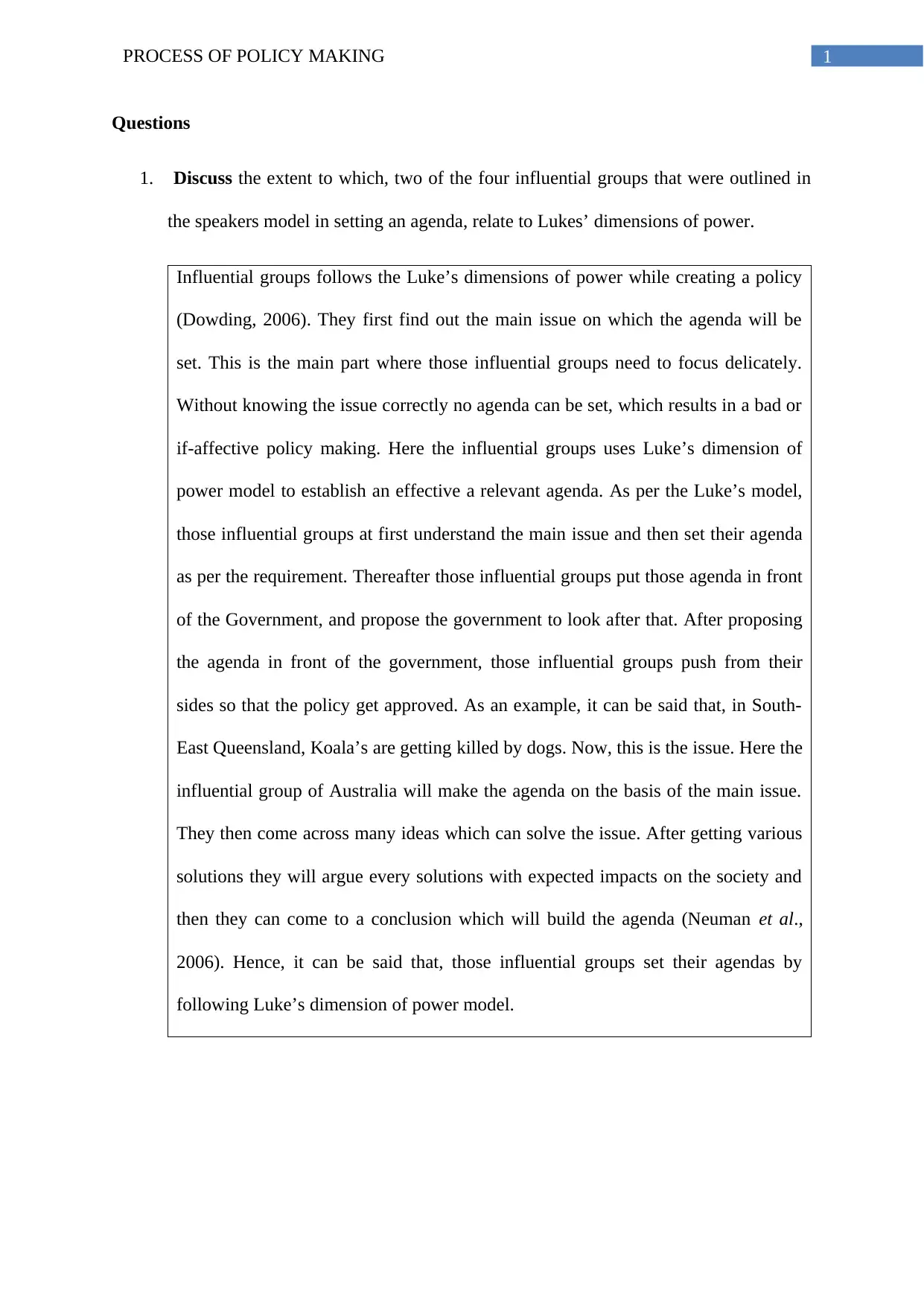
1PROCESS OF POLICY MAKING
Questions
1. Discuss the extent to which, two of the four influential groups that were outlined in
the speakers model in setting an agenda, relate to Lukes’ dimensions of power.
Influential groups follows the Luke’s dimensions of power while creating a policy
(Dowding, 2006). They first find out the main issue on which the agenda will be
set. This is the main part where those influential groups need to focus delicately.
Without knowing the issue correctly no agenda can be set, which results in a bad or
if-affective policy making. Here the influential groups uses Luke’s dimension of
power model to establish an effective a relevant agenda. As per the Luke’s model,
those influential groups at first understand the main issue and then set their agenda
as per the requirement. Thereafter those influential groups put those agenda in front
of the Government, and propose the government to look after that. After proposing
the agenda in front of the government, those influential groups push from their
sides so that the policy get approved. As an example, it can be said that, in South-
East Queensland, Koala’s are getting killed by dogs. Now, this is the issue. Here the
influential group of Australia will make the agenda on the basis of the main issue.
They then come across many ideas which can solve the issue. After getting various
solutions they will argue every solutions with expected impacts on the society and
then they can come to a conclusion which will build the agenda (Neuman et al.,
2006). Hence, it can be said that, those influential groups set their agendas by
following Luke’s dimension of power model.
Questions
1. Discuss the extent to which, two of the four influential groups that were outlined in
the speakers model in setting an agenda, relate to Lukes’ dimensions of power.
Influential groups follows the Luke’s dimensions of power while creating a policy
(Dowding, 2006). They first find out the main issue on which the agenda will be
set. This is the main part where those influential groups need to focus delicately.
Without knowing the issue correctly no agenda can be set, which results in a bad or
if-affective policy making. Here the influential groups uses Luke’s dimension of
power model to establish an effective a relevant agenda. As per the Luke’s model,
those influential groups at first understand the main issue and then set their agenda
as per the requirement. Thereafter those influential groups put those agenda in front
of the Government, and propose the government to look after that. After proposing
the agenda in front of the government, those influential groups push from their
sides so that the policy get approved. As an example, it can be said that, in South-
East Queensland, Koala’s are getting killed by dogs. Now, this is the issue. Here the
influential group of Australia will make the agenda on the basis of the main issue.
They then come across many ideas which can solve the issue. After getting various
solutions they will argue every solutions with expected impacts on the society and
then they can come to a conclusion which will build the agenda (Neuman et al.,
2006). Hence, it can be said that, those influential groups set their agendas by
following Luke’s dimension of power model.
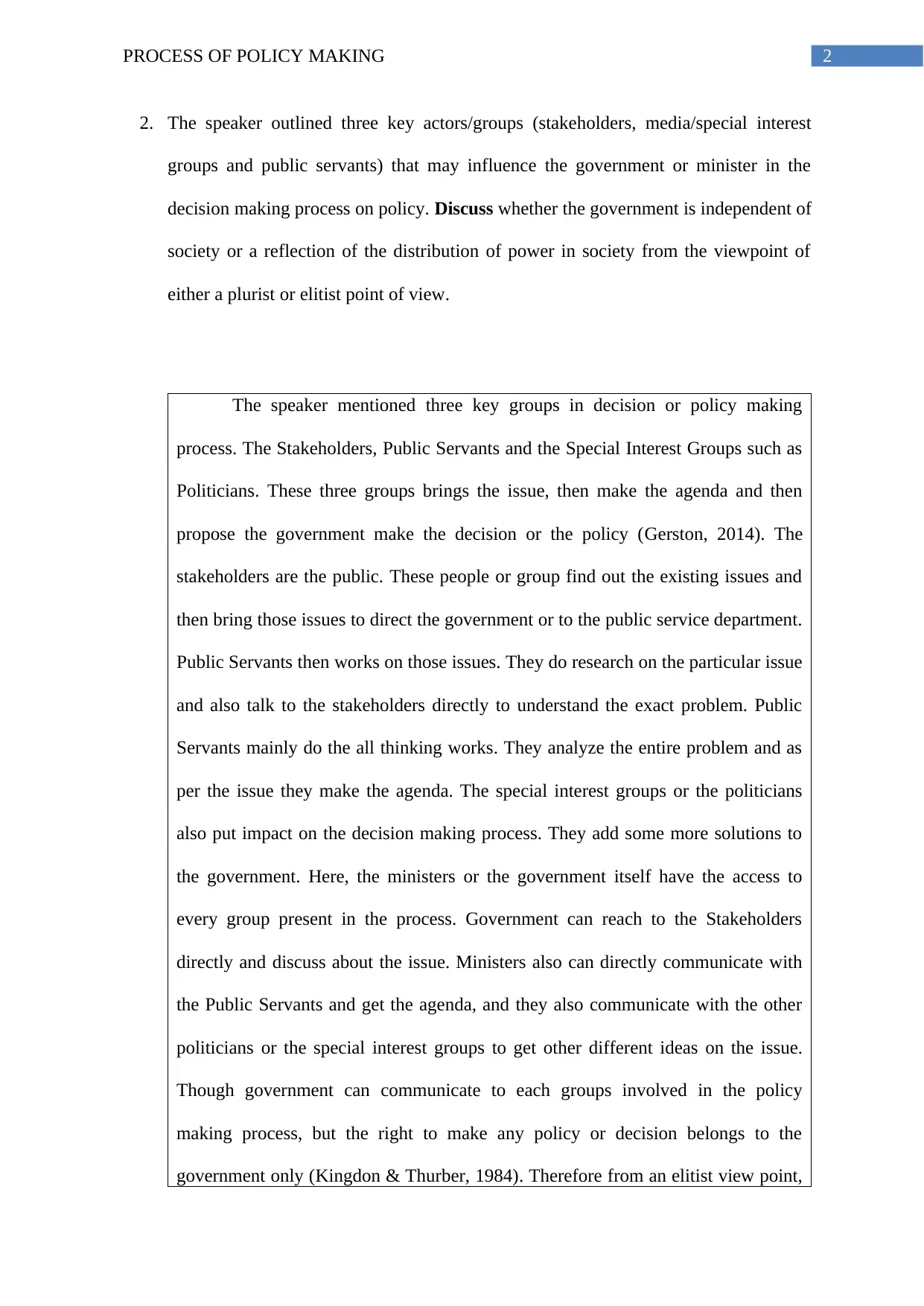
2PROCESS OF POLICY MAKING
2. The speaker outlined three key actors/groups (stakeholders, media/special interest
groups and public servants) that may influence the government or minister in the
decision making process on policy. Discuss whether the government is independent of
society or a reflection of the distribution of power in society from the viewpoint of
either a plurist or elitist point of view.
The speaker mentioned three key groups in decision or policy making
process. The Stakeholders, Public Servants and the Special Interest Groups such as
Politicians. These three groups brings the issue, then make the agenda and then
propose the government make the decision or the policy (Gerston, 2014). The
stakeholders are the public. These people or group find out the existing issues and
then bring those issues to direct the government or to the public service department.
Public Servants then works on those issues. They do research on the particular issue
and also talk to the stakeholders directly to understand the exact problem. Public
Servants mainly do the all thinking works. They analyze the entire problem and as
per the issue they make the agenda. The special interest groups or the politicians
also put impact on the decision making process. They add some more solutions to
the government. Here, the ministers or the government itself have the access to
every group present in the process. Government can reach to the Stakeholders
directly and discuss about the issue. Ministers also can directly communicate with
the Public Servants and get the agenda, and they also communicate with the other
politicians or the special interest groups to get other different ideas on the issue.
Though government can communicate to each groups involved in the policy
making process, but the right to make any policy or decision belongs to the
government only (Kingdon & Thurber, 1984). Therefore from an elitist view point,
2. The speaker outlined three key actors/groups (stakeholders, media/special interest
groups and public servants) that may influence the government or minister in the
decision making process on policy. Discuss whether the government is independent of
society or a reflection of the distribution of power in society from the viewpoint of
either a plurist or elitist point of view.
The speaker mentioned three key groups in decision or policy making
process. The Stakeholders, Public Servants and the Special Interest Groups such as
Politicians. These three groups brings the issue, then make the agenda and then
propose the government make the decision or the policy (Gerston, 2014). The
stakeholders are the public. These people or group find out the existing issues and
then bring those issues to direct the government or to the public service department.
Public Servants then works on those issues. They do research on the particular issue
and also talk to the stakeholders directly to understand the exact problem. Public
Servants mainly do the all thinking works. They analyze the entire problem and as
per the issue they make the agenda. The special interest groups or the politicians
also put impact on the decision making process. They add some more solutions to
the government. Here, the ministers or the government itself have the access to
every group present in the process. Government can reach to the Stakeholders
directly and discuss about the issue. Ministers also can directly communicate with
the Public Servants and get the agenda, and they also communicate with the other
politicians or the special interest groups to get other different ideas on the issue.
Though government can communicate to each groups involved in the policy
making process, but the right to make any policy or decision belongs to the
government only (Kingdon & Thurber, 1984). Therefore from an elitist view point,
⊘ This is a preview!⊘
Do you want full access?
Subscribe today to unlock all pages.

Trusted by 1+ million students worldwide
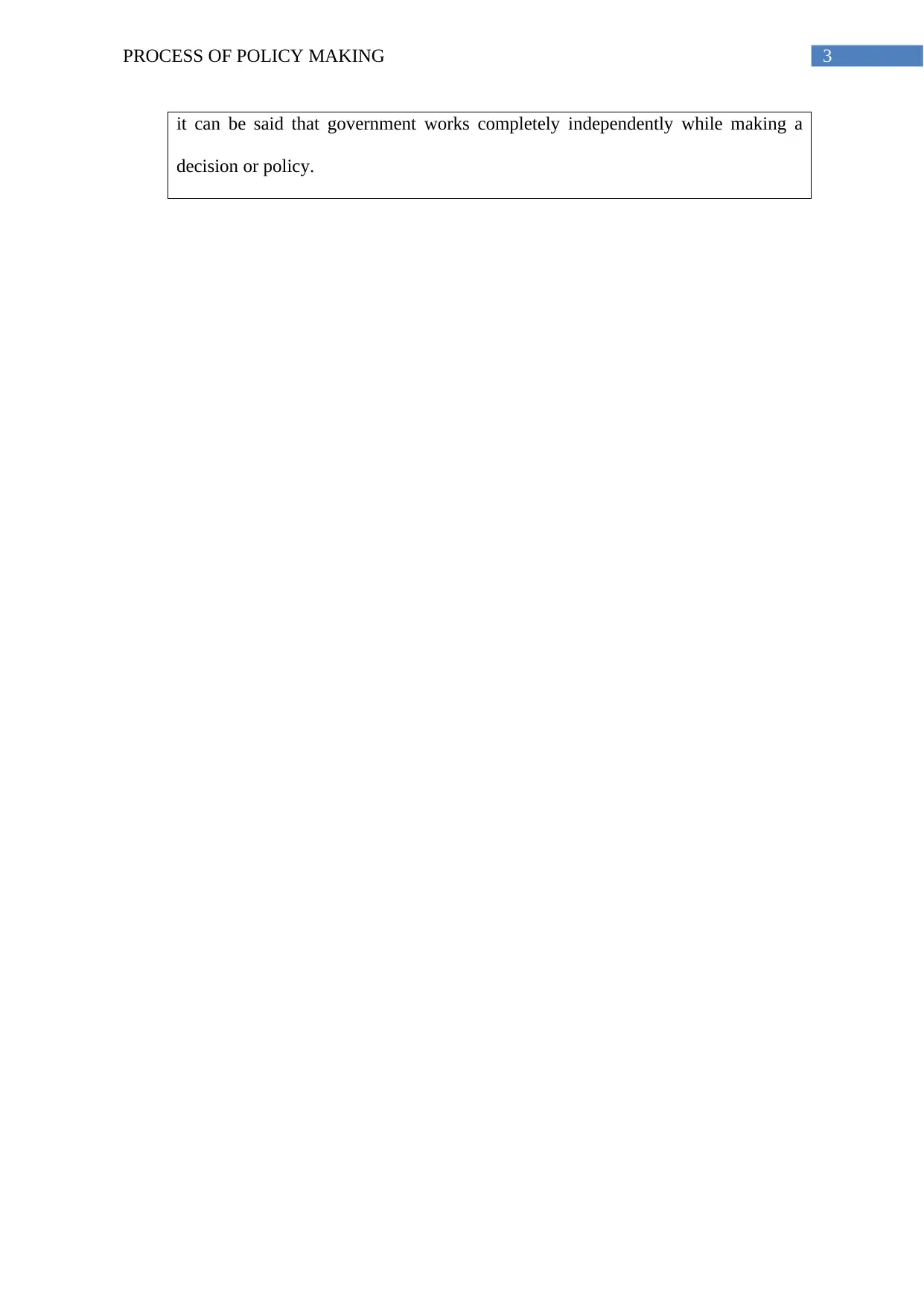
3PROCESS OF POLICY MAKING
it can be said that government works completely independently while making a
decision or policy.
it can be said that government works completely independently while making a
decision or policy.
Paraphrase This Document
Need a fresh take? Get an instant paraphrase of this document with our AI Paraphraser
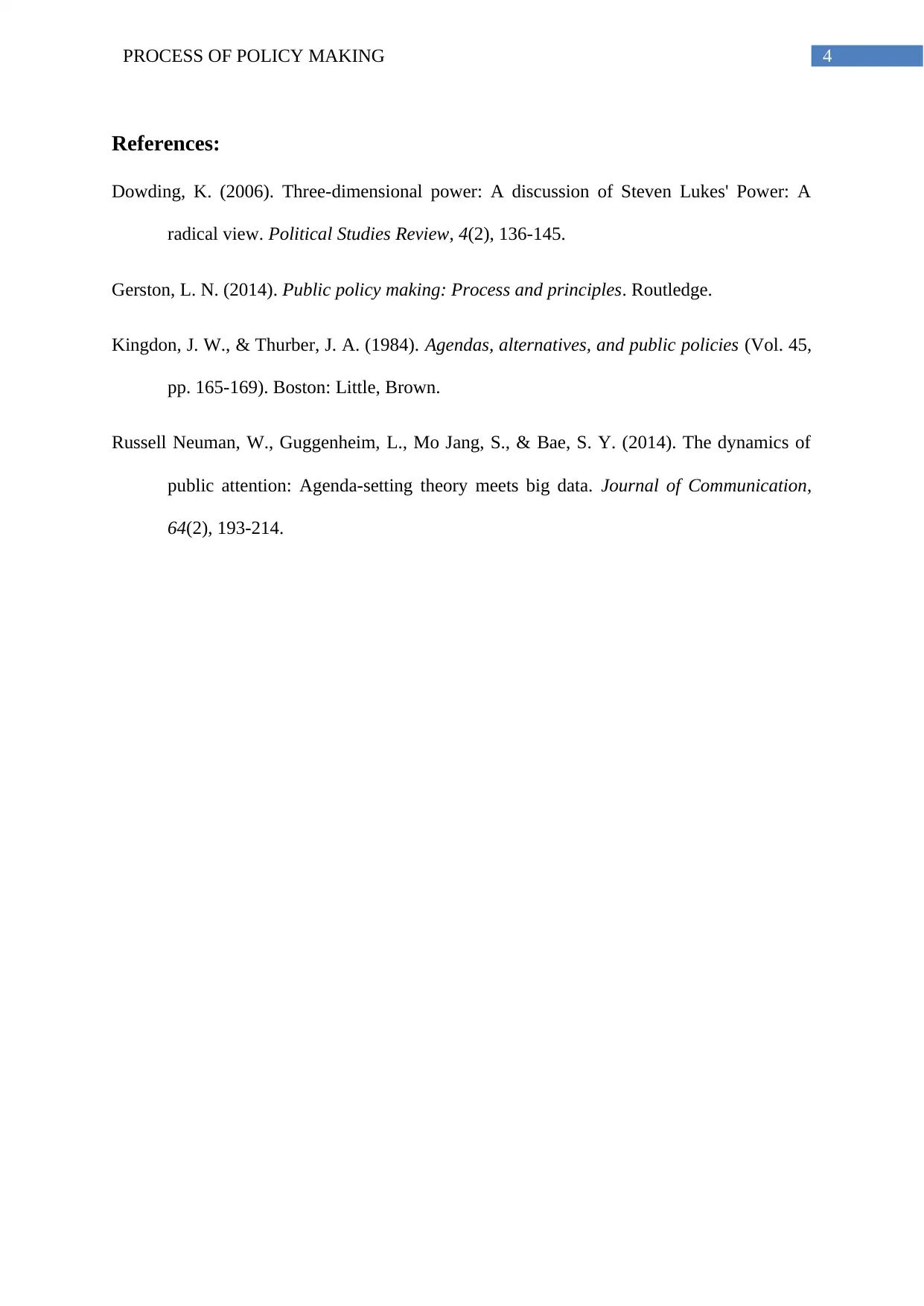
4PROCESS OF POLICY MAKING
References:
Dowding, K. (2006). Three-dimensional power: A discussion of Steven Lukes' Power: A
radical view. Political Studies Review, 4(2), 136-145.
Gerston, L. N. (2014). Public policy making: Process and principles. Routledge.
Kingdon, J. W., & Thurber, J. A. (1984). Agendas, alternatives, and public policies (Vol. 45,
pp. 165-169). Boston: Little, Brown.
Russell Neuman, W., Guggenheim, L., Mo Jang, S., & Bae, S. Y. (2014). The dynamics of
public attention: Agenda-setting theory meets big data. Journal of Communication,
64(2), 193-214.
References:
Dowding, K. (2006). Three-dimensional power: A discussion of Steven Lukes' Power: A
radical view. Political Studies Review, 4(2), 136-145.
Gerston, L. N. (2014). Public policy making: Process and principles. Routledge.
Kingdon, J. W., & Thurber, J. A. (1984). Agendas, alternatives, and public policies (Vol. 45,
pp. 165-169). Boston: Little, Brown.
Russell Neuman, W., Guggenheim, L., Mo Jang, S., & Bae, S. Y. (2014). The dynamics of
public attention: Agenda-setting theory meets big data. Journal of Communication,
64(2), 193-214.
1 out of 5
Related Documents
Your All-in-One AI-Powered Toolkit for Academic Success.
+13062052269
info@desklib.com
Available 24*7 on WhatsApp / Email
![[object Object]](/_next/static/media/star-bottom.7253800d.svg)
Unlock your academic potential
Copyright © 2020–2025 A2Z Services. All Rights Reserved. Developed and managed by ZUCOL.




